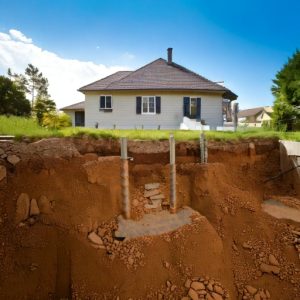Foundation issues are one of the most serious concerns for homeowners. When you notice cracks in your walls or floors, it’s easy to jump to conclusions, but not all cracks are created equal. Understanding the difference between cracked and settled foundations is crucial for determining the severity of the issue and whether it requires immediate attention. In this post, we’ll break down these two common types of foundation damage, how to recognize them, and what you can do to fix them.
What Is Cracked Foundation Damage?
1. The Basics of Cracked Foundations
A cracked foundation typically refers to visible fractures in the concrete or other materials that form the base of your home. These cracks can occur due to various factors, including shifting soil, water damage, or poor construction. Not all cracks are dangerous, but they can lead to bigger problems if left unchecked.
2. Types of Cracks
- Hairline Cracks: These are small, often barely visible cracks that don’t pose a significant threat but should still be monitored. They often result from normal settling or temperature fluctuations.
- Horizontal Cracks: These types of cracks are often a red flag. They typically appear in basement or foundation walls and may indicate pressure from expanding soil or water infiltration.
- Vertical Cracks: These cracks run up and down and can indicate settling or the movement of the foundation, usually not as serious as horizontal cracks but still worth investigating.
- Stair-Step Cracks: These cracks follow the lines of brick or mortar joints and are usually caused by uneven settling of the foundation. They are commonly found in older homes with brick or stone foundations.
3. Causes of Cracks
- Expansive Soils: Soils that expand when wet and shrink when dry, such as clay, can exert pressure on your foundation, causing cracks.
- Poor Drainage: Inadequate drainage around the foundation can lead to water buildup, which can erode soil or cause the foundation to shift.
- Tree Roots: Over time, tree roots can infiltrate and disrupt the foundation, leading to cracks.
- Temperature Changes: Extreme hot or cold temperatures can cause concrete to expand and contract, contributing to minor cracking.
What Is Settled Foundation Damage?
1. The Basics of Settling Foundations
A settled foundation occurs when the foundation sinks unevenly into the ground. This typically happens as a result of soil shifting, compaction, or erosion. A settled foundation isn’t always the same as a cracked one, but it can lead to cracks if left untreated. When your foundation settles, it causes the structure of your home to shift, potentially leading to damage in walls, floors, and even doors and windows.
2. Signs of a Settled Foundation
- Uneven Floors: If your floors begin to slope or feel uneven, it could be a sign that the foundation is settling.
- Misaligned Doors and Windows: When the foundation settles unevenly, doors and windows may stick or fail to open and close properly.
- Cracks in Walls: Settling foundations can cause larger cracks, especially around corners or the base of walls, which may spread over time.
- Exterior Shifts: Gaps between the foundation and exterior walls, or the appearance of the house leaning slightly, could also indicate settlement.
3. Causes of Settling
- Soil Compaction: If the soil under the foundation wasn’t properly compacted during construction, it may settle over time.
- Water Erosion: Poor drainage or excessive rainfall can erode the soil around your foundation, causing it to sink.
- Heavy Loads: Heavy structures or vehicles near the foundation can also exert pressure on the soil, causing it to settle.
- Tree Roots: Similar to cracks, tree roots can also disrupt the soil beneath the foundation, leading to settlement.
Cracks vs. Settling: How to Tell the Difference
1. Cracks in the Walls or Floor
While both cracks in the floor and walls can result from either settling or cracking, their appearance and location can give you clues about the cause.
- Cracks from Settling: These cracks are often wider at the top and taper off as they move down. They may also cause misaligned doors and windows.
- Cracks from Poor Construction or Water: These cracks tend to be smaller, straight, and more evenly distributed across surfaces.
2. Floors and Windows
- Uneven Floors: This is a common sign of a settled foundation. If your floor slopes or dips, the foundation may have settled unevenly.
- Windows That Stick: A settled foundation often causes window frames to shift, which may make them difficult to open or close.
When Should You Be Concerned?
1. Small Cracks vs. Large Cracks
While hairline cracks are usually not a cause for alarm, large cracks, especially those wider than 1/8 inch, may indicate serious foundation damage. Horizontal or stair-step cracks are more concerning, as they can suggest significant movement of the foundation.
2. Visible Shifting or Tilting
If the entire structure appears to be shifting, leaning, or if there is noticeable separation between the foundation and exterior walls, this is a strong indicator of a settled foundation. Immediate action should be taken to assess and address the issue before it worsens.
Repairing Cracked vs. Settled Foundations
1. Repairing Cracks
Cracks in your foundation can often be repaired by injecting epoxy or polyurethane foam into the cracks to seal them and prevent water intrusion. If the crack is wide or deeper, the foundation may need additional structural support or underpinning to stabilize it.
2. Repairing Settling Foundations
A settled foundation can be repaired by underpinning, which involves stabilizing the foundation by extending it deeper into more stable soil or installing additional piers. This can help lift the foundation back into place. Soil stabilization techniques, such as grouting or soil injection, may also be used to prevent further settling.
Conclusion
Cracked and settled foundations are common issues faced by homeowners, but they are not always the same. While cracks may be the result of temperature changes or minor soil movement, a settled foundation typically involves more significant shifts in the soil or structure. By understanding the difference between the two, you can more accurately diagnose the problem and take the appropriate steps to repair it. If you notice signs of either cracked or settled foundation damage, it’s important to consult a foundation repair professional to prevent further damage and ensure the stability of your home.






